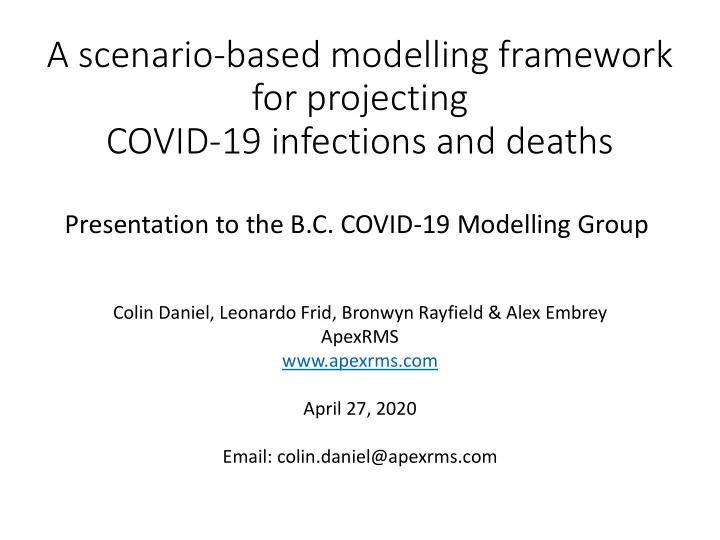

A scenario-based modelling framework for projecting COVID-19 infections and deaths Presentation to the B.C. COVID-19 Modelling Group Colin Daniel, Leonardo Frid, Bronwyn Rayfield & Alex Embrey ApexRMS www.apexrms.com April 27, 2020 Email: colin.daniel@apexrms.com
In my presentation today - 1. Present a general framework for forecasting COVID-19 infections and deaths 2. Demonstrate using a simple infection/death growth model Canada and 4 provinces Looking for feedback on both! 2
Challenges forecasting for COVID-19 “All models are wrong, some are useful” -Bonnie Henry What makes a model useful? It must be “actionable” by decision makers Model delivery is as important as the underlying model 3
What makes for effective COVID-19 model delivery? • Open-science models • Real-time forecasts • Interactive “what-if” policy gaming • Rapid deployment 4
Our contribution… Develop a general framework for COVID-19 modelling that leverages our existing SyncroSim software platform to deliver models to decision-makers 5
What is SyncroSim? Monte Carlo simulator • Automates scenario data • management • 10+ years of development Key Sponsors: (for ecological models) • Free download: www.syncrosim.com 6
What is SyncroSim? Support model & data “pipelines” • Models written in any language • e.g. R, Python, C# & executables User interface and full command-line API • e.g. rsyncrosim R package 7
What is SyncroSim? Start with a model 8
What is SyncroSim? Add Input & Output Tables 9
What is SyncroSim? Connect to SyncroSim 10
What is SyncroSim? Input Table Add XML configuration file to describe inputs & outputs 11
What is SyncroSim? SyncroSim then automatically tracks all your inputs & outputs… 12
What is SyncroSim? … and provides a suite of built-in “what-if” scenario building tools 13
What is SyncroSim? SyncroSim also support publishing models online as a SyncroSim Package (through GitHub) … 14
What is SyncroSim? … and delivering online parameter updates using SyncroSim Templates See www.apexrms.com/covid19 for example 15
Framework case study model: Forecasting COVID-19 infections and deaths for Canada and four provinces 16
Model Approach • Fits death growth curve • Similar to the U.S. IMHE 1 model except: Also calculates infections Different approach to fitting growth curves 1 Institute for Health Metrics and Evaluation (IHME) – www.healthdata.org 17
Step 1: Back-calculate infections from deaths Daily Infections: Δ I t = I t - I t-1 = D t+i / F t Where I t = cumulative infections on day t F t = age-standardized infection fatality rate on day t i = infection period (incubation + symptoms) 18
Step 2: Project infections forward in time r t = time-varying daily growth rate I t+1 = I t (1 + r t ) (for 2-week forecasts) 19
Step 3: Calculate future deaths from infections D t = Δ I t-i F t-i All model inputs are random variables 20
Model Inputs 1. Age-standardized infection fatality rates: (Verity et al 2020) By jurisdiction: CA: 1.02% (0.55-1.96) BC: 1.07% (0.58-2.07) sampled as gamma distribution Also modelled base rates X 1.5 21
Model Inputs 2. Incubation Period: 4.5–5.8 days (Lauer et al 2020) 3. Symptom-to-Death Period: 16.9–19.2 days (Verity et al 2020) Sampled as uniform distributions 4. Daily Growth Rates: sampled from reference jurisdictions 22
Actual cumulative death growth rate up to and including April 17 Canadian rates following international trends 23
Modelled cumulative death growth rates for Canada (for Apr 18) Future rates sampled randomly from reference countries (actual) Actual Modelled 24
Model Inputs Start Date: Feb 12 (25 days prior to first death) End Date: 14 days after last death Forecasts generated daily: • starting April 18 to April 25 1000 Monte Carlo realizations • display 95% MC confidence interval 25
April 18 forecast: Canada National model projections for infections and deaths made 7 days ago 26
April 18 forecast: Canada Infection projections are sensitive to fatality rate assumption 27
April 18 forecast: British Columbia B.C. projections made 7 days ago 28
April 18 death forecast vs actual: Canada Actual deaths within 95% confidence interval of national projections for past 7 days 29
April 18 death forecast vs actual: B.C. For B.C. the model is projecting a bit higher than actual (due to spike in deaths on Apr 13) 30
April 18 death forecast vs actual: Alberta Model projections tracking actual deaths for Alberta 31
April 18 death forecast vs actual: Ontario Projections also tracking actual for Ontario 32
April 18 death forecast vs actual: Quebec Projections tracking for Quebec (but also a bit high) 33
April 18 vs April 25 death forecasts: B.C. Compare projections made one week apart for B.C.: Latest projections are more stable (as actual deaths stabilize) 34
Cumulative death growth rate up to and including April 17 How did actual growth rates change over past week? 35
Cumulative death growth rate up to and including April 25 B.C. and Quebec rates declined a bit more rapidly than reference countries: as a result model forecasts are a bit high 36
Cumulative death growth rate up to and including April 25 Forecasts could likely be improved (and extended in time) if we could add case data to better anticipate death trends 37
Summary • Framework established for rapid deployment of daily COVID-19 forecasts • Positioned to assimilate public health changes in other jurisdictions e.g. Δ r in Spain, Germany, U.S. states, etc. • Positioned to do local “what-if” analyses e.g. what if B.C. infection growth rate increased from 3% to 4/5/6/7% on May 1? 38
Next Steps 1. Refine existing model? Improve reference curve selection Alternative approaches? e.g. Add Cases? 2. Bring other models into framework Help represent “between model” uncertainty Generate mor model-informed scenarios Candidate C#/VB/R models in B.C.? 3. Operationalize the framework? 39
Recommend
More recommend